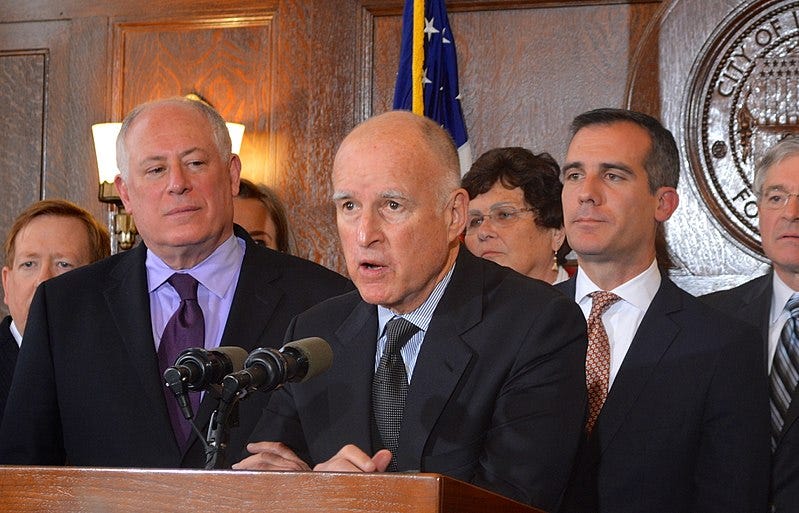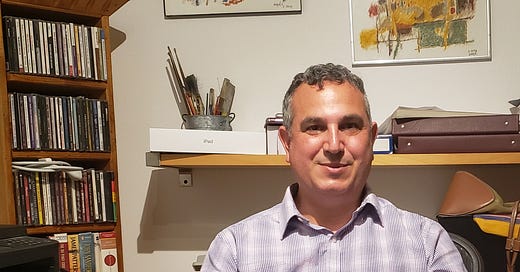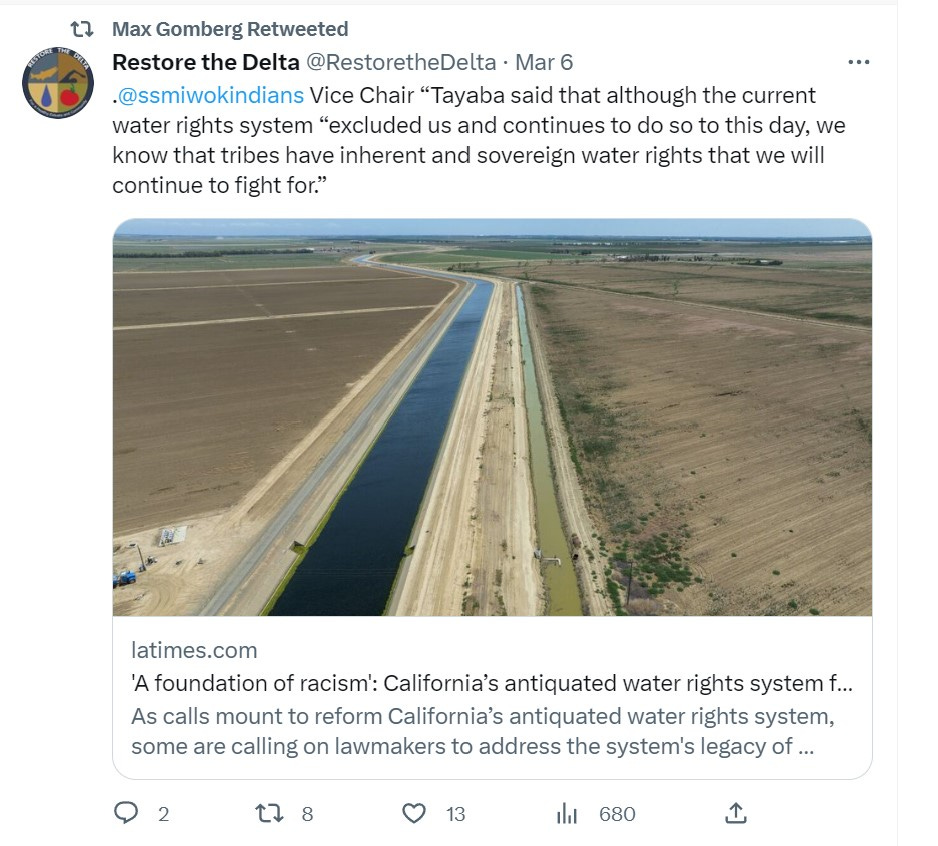Gavin Newsom's 'culture of distrust' revealed by ex water conservation manager
Max Gomberg tells about working for environmental justice at the State Water Board under Govs. Jerry Brown and Gavin Newsom
I’m reposting this interview in two parts to add context to my “We the People” series underway presently. Since it was published was first posted two years ago SoCal Water Wars has gained thousands of subscribers and followers, many within the past six months, who did not have a chance to read it. — JE
This is the first of two parts from my interview with Max Gomberg that took place recently in Santa Monica, in which he talks about how he got to work for the water board and the differences in management styles between Gov. Jerry Brown and Newsom that led to his departure.
Max Gomberg served as a conservation manager for the California State Water Resources Control Board for ten years under Governors Jerry Brown and Gavin Newsom. Working there, he faced challenges from two historic droughts, climate change, and the pandemic.
Gomberg resigned in July of last year in a letter addressed to “everyone.” In it, he warned of “dark and uncertain times” due to rising fascism and decreasing habitability on Earth from human-caused climate change.
Gomberg slammed the Governor’s failure to adequately respond to those issues. “Sadly,” he wrote, “this state is not on a path towards steep cuts in greenhouse gas emissions.”
Gomberg looks at climate change and water management though an environmental-justice lens. He calls for massive housing construction instead of more prisons, reduced law enforcement budgets, and sharp cutbacks in big-agriculture in order to reallocate “resources to programs that actually increase public health and safety.”
He accuses Gov. Newsom of blocking the ability of his handpicked water board to respond to climate change with policies that promote the reasonable use of water and environmental justice.
SoCal Water Wars: You worked at the State Water Board for about ten years. How did you get that job?
Max Gomberg: Attending graduate school in Los Angeles, I longed to return to the Bay Area where I knew more people. In my first summer back I enjoyed working as an intern ratepayer advocate at the Public Utilities Commission.
So I applied for two full-time jobs at the PUC. One was on the water side and one was on the energy side.
A lot of bright and motivated people were already coming into the energy sector because of its existing dynamism, developing energy renewables and moving away from fossil fuels.
Water was the stepchild at the PUC and always will be because there’s less to regulate there. I felt I could do more on the water side. I haven’t looked back since.
I was an advocate at the PUC for about five years and had gotten involved with the legislative subcommittee for AB 32, the big climate change law that passed in 2006. Following that, the state government organized various agency climate groups.
One of those groups had the funny name, WETCAT, the Water and Energy Team of the Climate Action Committee.
Through my PUC acquaintances, I started going to meetings. One of the facilitators was Fran Spivy-Weber, who was on the State Water Board.
I really wanted to be involved in statewide policy making. And you can't do that if you're in water at the PUC. I knew I needed to have a Sacramento job, and Fran encouraged me.
About a year later she said, “Hey, actually we're going to be able to hire someone.’” Because when AB 32 was passed, the state created a whole bunch of new positions to implement it. A couple of those positions were spun off to the Water Board.
So I was the first person hired specifically to work climate at the Water Board. In 2014, the state went into drought and I got a budget for building up drought-response staff. In 2015, I wrote legislation to start regulation on water loss from leaks. That was SB 555.
I also took on low-income water rate assistance through AB 401, passed in 2015.
So I started building up the staff and sort of became manager, creating a team that had never existed before and covered a bunch of issues under the banner of climate during the administrations of Gov. Jerry Brown and Gavin Newsom.
Most of that evolution took place under the Brown administration. When Newsom came in (2019), I had my team, but it grew some due to 2018 legislation for water conservation standards.
SoCal Water Wars: What was it like working under Newsom? Were you in touch with him?
Max Gomberg: I didn’t work directly under him and never interacted with him. I did interact directly with various people who worked directly for Brown when he was governor.
But the work-dynamic became very different under Newsom.
SoCal Water Wars: How so?
Max Gomberg: Brown was hands off. He had a small staff and trusted his department heads to run things without much oversight. There are agency secretaries, the state cabinet, and Brown gave them a lot of latitude to be innovative.
From 2012 through 2018 I had a lot more room to be creative; to say, “Hey, I'd like to write a bill on this and run with it.” There was a lot of willingness in the Brown administration to [let us] go for it and see what happens.
SoCal Water Wars: You didn't feel inhibited under the Brown administration.
Max Gomberg: Right. Then the Newsom administration came in with a major priority that the Brown hadn’t accomplished: pass a safe drinking water bill to protect low-income high-unemployment communities that lacked clean water supplies.

The state's primary way of funding drinking water is through the State Revolving Fund, a federal program. Those funds can only be used for building infrastructure, not for ongoing operations and maintenance. Advocates had been pushing for years to get the state to approve some type of fund for that.
Newsom promised, “I’m going to get this done.” And he did in 2019 by signing SB 200.
To be fair, that was a major accomplishment for which he deserves credit. But he also deserves all the subsequent criticism he received for other water-management decisions he made.
But the water board needed to make a plan to spend the money, once we got it, efficiently and in line with community needs, toward a sustainable provision of safe drinking water.
So I was put on assignment by Newsom’s staff and told that my new priority was to work with a leadership group within the water board to create that plan.
Our leadership group had to figure out which communities would be highest on the priority list, how many systems we could get assistance to and in what timeline, workforce development, and different types of treatment technologies.
I was tasked with with creating a community advisory group for funding on the assumption that it would materialize through the political process in the legislature.
So we came up with a list of people and entities we thought should be on this advisory group, thinking that we would be able to run with it.
Well, it was an advisory group to the Water Board, which has five gubernatorial appointees who run it. And we were told that the governor's office wants to review and approve our list.

So this advisory group, which I was the lead on, went to the governor's office and we were essentially told to take off a couple of community members and put on a couple of big-ag representatives instead.
By that time, I was already frustrated with what I consider to be the overly controlling nature of the Newsom administration. All of that encouragement from the Brown administration to be creative was replaced by a “you-are-going-to-do-this-and-only-this” message coming from the Governor’s office.
I informed one of the advocacy organizations what had happened and they called the Governor’s office. Only a few people had access to that list. So, rather than go through a whole rigmarole about finding out who the leaker was, I admitted it was me.
The Governor’s people weren’t happy. I got yanked off that project and was banned from any future meetings with the Governor’s office (which led to some funny moments where my staff were invited to meetings I couldn’t attend about projects I was working on).
But I still had purview to get a report to the legislature on assisting low-income ratepayers to pay their water bills. I also advanced regulations on water-loss (leak) control and next generation water conservation standards, and was involved in climate discussions, but not at a higher political level.
Then COVID hit, so I was involved in planning to distribute money to people who were out of work due to COVID and couldn’t pay their [water] bills. And a couple of my staff were on a committee writing up a racial equity resolution, but not me.
So I wasn’t completely written out of things.
And I would hear reports from my staff about how serious ideas would get shot down repeatedly by the executive team or specific board members. In particular about water rights and addressing the racist basis for the current system. That really pissed off the staff and it got pretty heated.
For example: the staff committee working on the board’s racial equity resolution had drafted language that explicitly called out the water-rights system for resting on a foundation of racism and the displacement of indigenous people. But board member Dorene D'Adamo took issue with the language and made edits to soften it. When staff pushed back, the Board's executive team shut them down and watered down the language.
About that time, Newsom was intimidating the Regional Water Board over the Poseidon desal project and generally ignoring the vast inequities in water management.
At times, it felt like his administration was using its good reputation, earned for providing safe drinking water, as a cover for a series of bad decisions made about water rights, drinking water regulation, financial assistance, groundwater management, conservation, you name it.
I watched as what the board was allowed to do and the policy options acceptable to the governor shrank.
Information that used to be shared freely across the hierarchy was kept at the very top. A culture of distrust had developed with growing friction between staff and the board’s leadership. And it was clear that I sided with staff.
It became a very unpleasant place to work because of the top-down politics. And the way the leadership handled it was to suck up to the political appointees and slap down the staff who were trying to do the right thing.
End of Part 1
See also:






Max complains that he did not have free reign under Newsom to pursue his progressive ideas for improving society. I don’t remember voting for Max for Governor. I suggest he run for high office and see how many people in our democracy buy into his very left wing views.